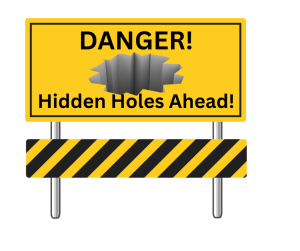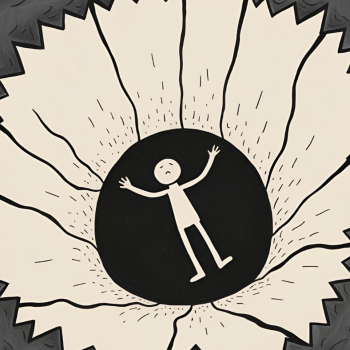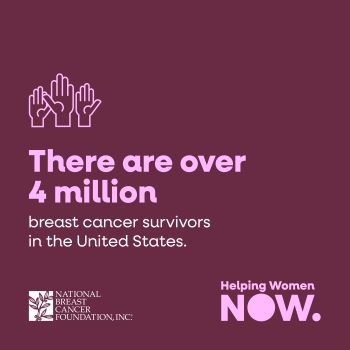Building Your Life on Rock Bottom

The hero walks across what appears to be regular sand. They stop walking, and then we see them slowly start to shrink. They’ve found the one patch of quicksand to stand in.

The dangers of quicksand feature larger in my mind than they actually do in real life. To the extent that I think of quicksand as the visual when I think of my mental health struggles. I don’t drown in water when I struggle, but in quicksand. At the bottom of the quicksand hole is my rock bottom.

According to the Cambridge Dictionary (online edition), rock bottom means “the lowest possible level”. We love movies and stories about people who have hit rock bottom and then climbed out to become stronger, richer, more powerful, at peace, etc. We watch this story play out in movies, YouTube videos, articles, books, and word of mouth. We love watching people overcome.
“Fall seven times, stand up eight.”
— Japanese Proverb
This is a powerful narrative. In movies, which helpfully give us great visuals, the image of a person broken physically, mentally, and emotionally, with the sad music playing in the background, is the lowest point in the story. But we know what comes next. The music starts to change, the person gathers themself, pushes up off the ground, staggers around at first, but as the music grows triumphant and they grow visually stronger. The audience cheers, our hearts swell, and we ride the good endorphins to the end.
“People dealing with trauma and depression don’t magically get better overnight. It’s not like in the movies, Mary. There’s no magic reset button at rock bottom.”
― Benjamin W. Bass, Alone In The Light
This is the Hero’s Journey, and we love it. It gives us hope, and we feel camaraderie, a kinship with the one suffering. Because everyone hits rock bottom at some point in their life. It’s just a fact of life. Each and every person’s rock bottom happens differently. We like to believe that, like the movies, everyone gets up to finish their fight, conquer their addiction, climb their way to success, and stand on the top of that mountain of triumph.
“The best stories come from rock bottom.”
― Trevor Carss
And yet, not everyone does.
“It’s not like in the movies, Mary. There’s no magic reset button at rock bottom.”
— Benjamin W. Bass
Some, sadly, never make it off the bottom. That becomes their end, whether they die at that time or years later. Some struggle to climb out, make it a few steps up, and then slide back down. A few of these will give up, while others will continue to struggle and fight every day for the rest of their lives. And some do climb out of the hole, but don’t continue to build themselves a mountain of victory to stand on.
“And I know, knew for sure, with an absolute certainty, that this is rock bottom, this what the worst possible thing feels like. It is not some grand, wretched emotional breakdown. It is, in fact, so very mundane:…Rock Bottom is an inability to cope with the commonplace that is so extreme it makes even the grandest and loveliest things unbearable…Rock bottom is feeling that the only thing that matters in all of life is the one bad moment…Rock bottom is everything out of focus. It’s a failure of vision, a failure to see the world how it is, to see the good in what it is, and only to wonder why the hell things look the way they do and not—and not some other way.”
― Elizabeth Wurtzel, Prozac Nation
There are many reasons why some people triumph over their rock bottom and some do not. If you’re struggling with your rock bottom and cannot figure it out, don’t fight alone. We all need help sometimes to figure things out. Talking with someone can provide you with new tools to help you climb that you did not know about, work through with you the things that led to the rock bottom that need to be changed before you can move forward, or even just offer a different way of viewing rock bottom.
“Success is how high you bounce after hitting the bottom.”
— George S. Patton

This happened to me recently. Not only was I dealing with hitting rock bottom again, because we don’t just have one rock bottom in life, but with someone I loved very much falling into their own hole, headed for rock bottom. My heart ached for them and the pain they were suffering and were going to suffer. I felt unable to help them due to being in my own hole.

I’ve always envisioned episodes of hitting rock bottom as falling into one of the quicksand sections of the path I walked in life. (As with many people in my generation, I thought quicksand would be way more prevalent than it actually is in life.) You stumbled into the spot, struggled, but were still pulled down until you hit the bottom. At that point, you then had to crawl your way out of the hole.
“Often, the gift of hitting rock bottom is that it persuades you to change and move forward.”
― Brittany Burgunder
This rock bottom was different. I struggled to climb my way out in the ways I had used in the past. I would reach just high enough to see daylight again, but then slip and fall back down to the bottom. Life was growing frustrating and dark. I did not want to spend years of my life trying to get out of this hole.

In the past, hitting and bottom were the parts of this common phrase that struck me. Hitting was pain and suffering. Bottom was the lowest point, the encouragement that the falling and hitting was done, and now I could move forward and upward. This time, rock stood out to me. A song I sang as a child, that I sang with my children, and still sing when I teach young children, popped into my head.
The Wise Man and the Foolish Man
This song is taken from the parable Jesus told his followers and was recorded in Matthew 7:24-27. “24 “Everyone then who hears these words of mine and does them will be like a wise man who built his house on the rock. 25 And the rain fell, and the floods came, and the winds blew and beat on that house, but it did not fall, because it had been founded on the rock. 26 And everyone who hears these words of mine and does not do them will be like a foolish man who built his house on the sand. 27 And the rain fell, and the floods came, and the winds blew and beat against that house, and it fell, and great was the fall of it.” (ESV)
“Rock bottom became the solid foundation on which I rebuilt my life.”
― J.K. Rowling

A rock is a much better foundation for building on than sand. As the parable says, sand is unstable and crumbles away easily. It does the same thing when you’re trying to climb up from rock bottom.
“Experience is a brutal teacher. But you learn. My god, you learn.”
— C.S. Lewis
It was time to change my thinking on hitting rock bottom. This time, instead of climbing out, I would use the rock as my solid foundation to build up my life. The Bible uses other terms and uses for Jesus as a rock. He is the cornerstone (Psalm 118:22), our anchor (Hebrews 6:19), a firm foundation (2 Timothy 2:19), and a tower (Proverbs 18:10).
“As it turns out, it was that very rock bottom that became the firmest foundation I had ever planted my feet on.” — Mandy Hale
Instead of climbing up the crumbly sides of sand, I’m sweeping sand away to expose more of the rock I’m building on. One of the points in moving from rock bottom is to examine yourself and your life. Figure out what got you to where you are. Use that knowledge to change what needs to be changed and strengthen what needs to be strengthened. Cut out the false beliefs and ideas and bring in truth. Change your lifestyle, recognize wrong thought patterns, and work to replace them with the right ones.
“Some of my lowest points were the most exciting opportunities to push through to be a better person.”
— Demi Moore

I always tell my patients that healing, either physically or mentally, cannot be done in a single day, with a single medication, or with a single tool. There’s more to you than that. I’ve been working with a counselor for my mental health, a doctor for my physical health, and working to change the way I live. If I want my life to go in a certain direction after hitting rock bottom, I have to plan and do in every area of my life.
“When I’m at the bottom looking up, the main question may not be ‘how do I get out of this hole?’ In reality, the main question might be ‘how do I get rid of the shovel that I used to dig it?”
— Craig D. Lounsbrough
You may see rock bottom as a trampoline to bounce you out of your breakdown. Or, you may see it as a solid foundation to build your life upon. Either way, rock bottom can be scary, and it is always hard. I think Dave Ramsey said it best:
“Hitting bottom and hitting it hard was the worst thing that ever happened to me and the best thing that ever happened to me.”












